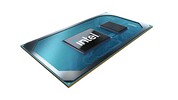Intel Core i5-1155G7 vs Apple M1 Pro
Intel Core i5-1155G7
► remove from comparison
The Intel Core i5-1155G7 is a power efficient quad-core SoC for laptops and Ultrabooks based on the Tiger Lake-U generation that was announced in mid 2021 as part of the refresh. It integrates four Willow Cove processor cores (8 threads thanks to HyperThreading). The base clock speed depends on the TDP settings and ranges from 1 GHz (12 Watt TDP) up to 2.5 GHz (28 Watt). Boost clock speed is 4.5 GHz.
Tiger Lake SoCs add PCIe 4 support (4 lanes), AI hardware acceleration, and the partial integration of Thunderbolt 4 / USB 4 and Wifi 6 in the chip.
Another novelty is the integrated Xe graphics adapter with 80 EUs based on the completely new Gen 12 architecture. It offers a significantly higher performance compared to the older Iris Plus G7 (Ice Lake).
Performance
The average 1155G7 in our database proves to be a very decent mid-range processor, as of mid 2022, trading blows with the Core i7-10810U and the Ryzen 5 4500U as far as multi-thread benchmark scores are concerned. While perhaps not the best option for power users, this Core i5 will make most consumers happy, providing for short load times and generally pain-free experience.
Your mileage may vary depending on how high the CPU power limits are and how competent the cooling solution of your system is.
Power consumption
This Core i5 series chip has a default TDP, also known as the long-term power limit, of 12 W to 28 W, the expectation being that laptop makers will go for a higher value in exchange for higher performance. Either way, this is a tad too high to allow for passively cooled designs.
The i5-1155G7 is built with Intel's third-gen 10 nm process marketed as SuperFin for lower-than-average, as of early 2023, energy efficiency.
Apple M1 Pro
► remove from comparison
The Apple M1 Pro is a System on a Chip (SoC) from Apple that is found in the late 2021 MacBook Pro 14 and 16-inch models. It offers all 10 cores available in the chip divided in eight performance cores (P-cores with 600 - 3220 MHz) and two power-efficiency cores (E-cores with 600 - 2064 MHz). There is no Turbo Boost for single cores or short burst periods. The cores are similar to the cores in the Apple M1. The entry level model offers only 8 cores.
The big cores (codename Firestorm) offer 192 KB instruction cache, 128 KB data cache, and 24 MB shared L2 cache (up from 12 MB in the M1). The four efficiency cores (codename Icestorm) are a lot smaller and offer only 128 KB instruction cache, 64 KB data cache, and 4 MB shared cache. CPU and GPU can both use the 24 MB SLC (System Level Cache). The efficiency cores (E cluster) clock with 600 - 2064 MHz, the performance cores (P cluster) with 600 - 3228 MHz.
The unified memory (16 or 32 GB LPDDR5-6400) next to the chip is connected by a 256 bit memory controller (200 GB/s bandwidth) and can be used by the GPU and CPU.
The integrated graphics card in the M1 Pro offers all 16 cores.
Furthermore, the SoC integrates a fast 16 core neural engine, a secure enclave (e.g., for encryption), a unified memory architecture, Thunderbolt 4 controller, an ISP, and media de- and encoders (including ProRes).
The M1 Pro is manufactured in 5 nm at TSMC and integrates 33.7 billion transistors. The peak power consumption of the chip was advertised around 30W for CPU intensive tasks. In the Prime95 benchmark the chip uses in our tests (with a MBP16) 33.6W package power and 31W for the CPU part. In idle the SoC only reports 1W package power.
| Model | Intel Core i5-1155G7 | Apple M1 Pro | ||||||||||||||||||||||||||||||||||||||||||||||||
| Codename | Tiger Lake-UP3 | |||||||||||||||||||||||||||||||||||||||||||||||||
| Series | Intel Tiger Lake | Apple M1 | ||||||||||||||||||||||||||||||||||||||||||||||||
| Series: M1 |
|
| ||||||||||||||||||||||||||||||||||||||||||||||||
| Clock | 2500 - 4500 MHz | 2064 - 3220 MHz | ||||||||||||||||||||||||||||||||||||||||||||||||
| L1 Cache | 320 KB | 2.9 MB | ||||||||||||||||||||||||||||||||||||||||||||||||
| L2 Cache | 5 MB | 28 MB | ||||||||||||||||||||||||||||||||||||||||||||||||
| L3 Cache | 8 MB | 24 MB | ||||||||||||||||||||||||||||||||||||||||||||||||
| Cores / Threads | 4 / 8 | 10 / 10 | ||||||||||||||||||||||||||||||||||||||||||||||||
| TDP | 28 Watt | |||||||||||||||||||||||||||||||||||||||||||||||||
| Technology | 10 nm | 5 nm | ||||||||||||||||||||||||||||||||||||||||||||||||
| max. Temp. | 100 °C | |||||||||||||||||||||||||||||||||||||||||||||||||
| Socket | BGA1449 | |||||||||||||||||||||||||||||||||||||||||||||||||
| Features | DDR4-3200/LPDDR4x-4266 RAM, PCIe 4, 4 GT/s bus, DL Boost, GNA, MMX, SSE, SSE2, SSE3, SSSE3, SSE4.1, SSE4.2, AVX, AVX2, AVX-512, BMI2, ABM, FMA, ADX, VMX, SMEP, SMAP, EIST, TM1, TM2, HT, Turbo, SST, AES-NI, RDRAND, RDSEED, SHA | ARMv8 Instruction Set | ||||||||||||||||||||||||||||||||||||||||||||||||
| iGPU | Intel Iris Xe Graphics G7 80EUs (400 - 1350 MHz) | Apple M1 Pro 16-Core GPU | ||||||||||||||||||||||||||||||||||||||||||||||||
| Architecture | x86 | ARM | ||||||||||||||||||||||||||||||||||||||||||||||||
| Announced | ||||||||||||||||||||||||||||||||||||||||||||||||||
| Manufacturer | ark.intel.com | |||||||||||||||||||||||||||||||||||||||||||||||||
| Transistors | 33700 Million |
Benchmarks
Average Benchmarks Intel Core i5-1155G7 → 100% n=14
Average Benchmarks Apple M1 Pro → 157% n=14
* Smaller numbers mean a higher performance
1 This benchmark is not used for the average calculation












